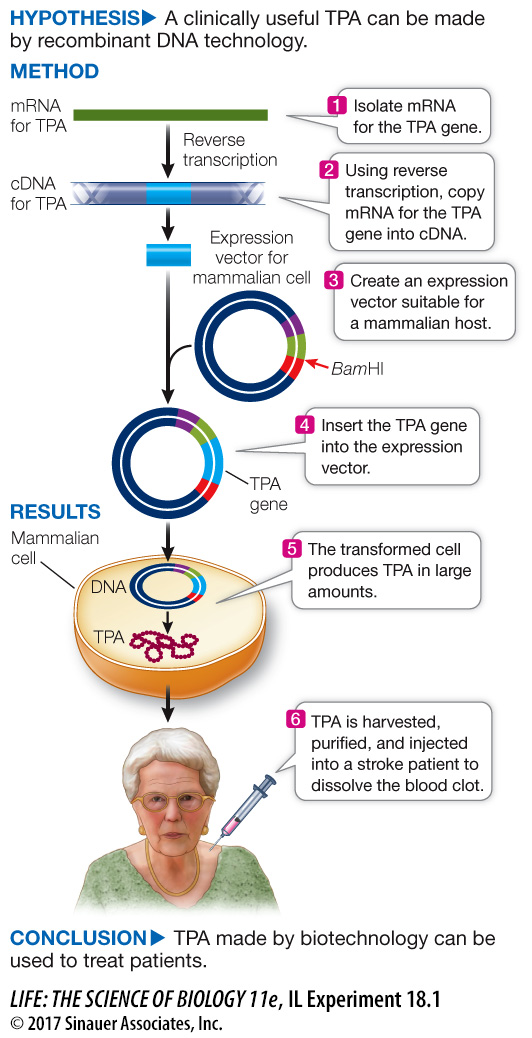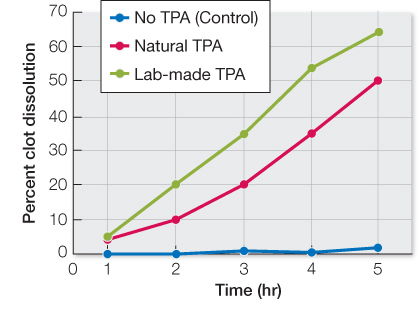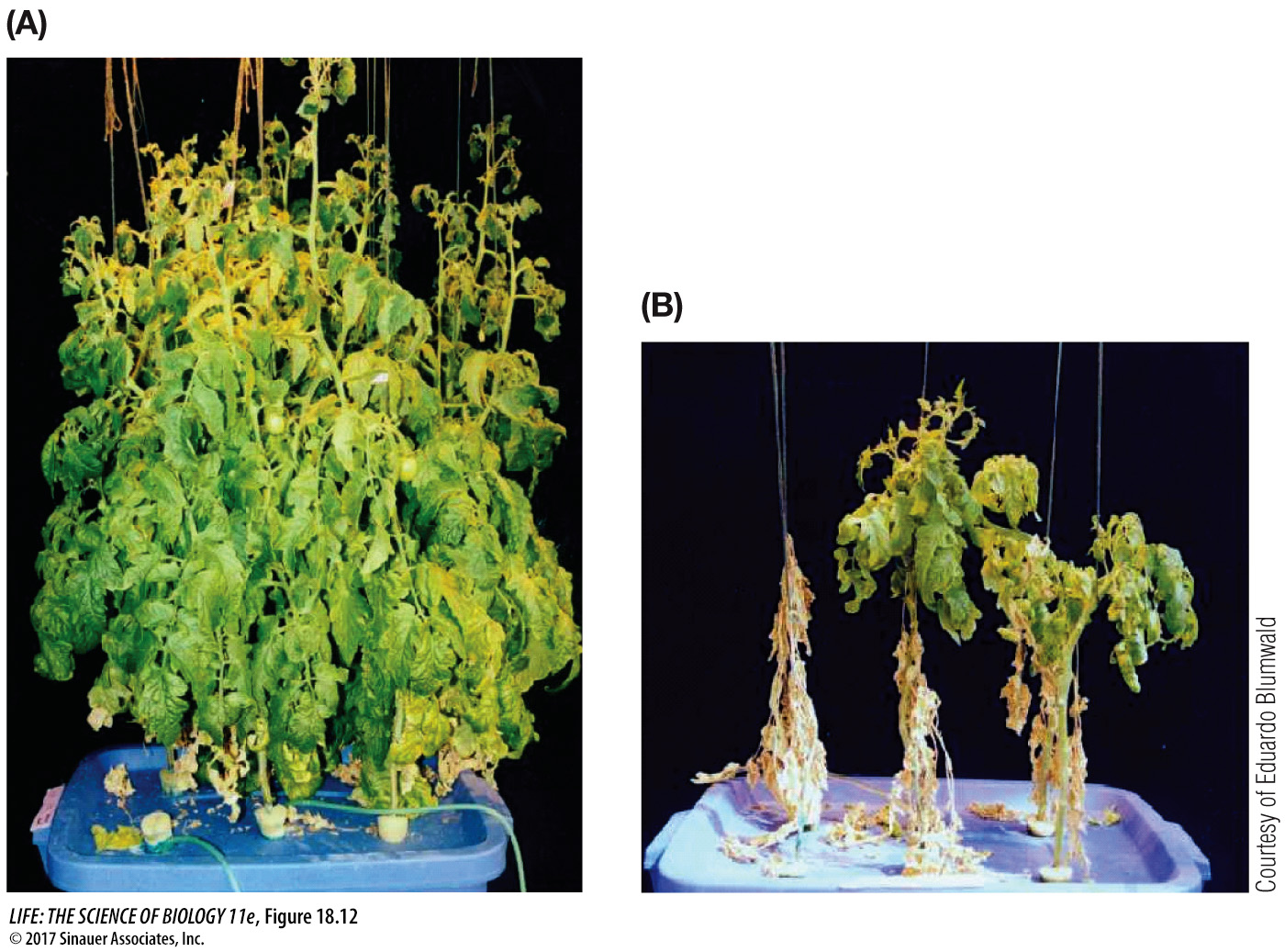DNA manipulation is changing agriculture
The cultivation of plants and the husbandry of animals provide the world’s oldest examples of biotechnology, dating back more than 10,000 years. Over the centuries, people have adapted crops and farm animals to their needs, producing organisms with desirable characteristics such as large seeds, high fat content in milk, or resistance to disease.
Until recently, the most common way to improve crop plants and farm animals was to identify individuals with desirable phenotypes that existed as a result of natural variation. Through many deliberate *crosses—a process called selective breeding—
*connect the concepts In genetics experiments, typically only a few genes and alleles are involved. But crop plants have phenotypes determined by many genes and alleles. This makes selecting genetically stable, desirable offspring from crosses between two varieties challenging. See Key Concepts 12.2 and 12.3.
Despite some spectacular successes—
Here are just some of the advantages that modern recombinant DNA technology offers over traditional methods of breeding:
The ability to identify specific genes. The development of genetic markers allows breeders to select for specific desirable genes, making the breeding process more precise and rapid.
The ability to introduce any gene from any organism into a plant or animal species. This ability, combined with mutagenesis techniques, vastly expands the range of possible new traits.
The ability to generate new organisms quickly. Manipulating cells in the laboratory and regenerating a whole plant or animal by cloning is much faster than traditional breeding.
investigating life
Producing TPA
experiment
For a protein such as TPA to become useful in the clinic, the expression of recombinant DNA (in this case, the TPA gene coupled to an active promoter) in cells must result in a large amount of the protein. The protein is then purified and used to treat patients with a stroke, by catalyzing the dissolution of a blood clot in an artery leading to the brain.
Original Paper: Collen, D. et al. 1984. Biological properties of human tissue-

work with the data
It is essential that a purified molecule made by biotechnology have the desired biological properties. In the case of TPA, the goal was to mimic the properties of the natural clot-
QUESTIONS
1.
Human blood clots were prepared in the lab using a radioactively labeled clotting molecule. Dissolution of the clot resulted in the radioactive molecules becoming hydrolysis products (monomers), so comparing soluble to insoluble radioactivity was a measure of clot dissolution. Table A shows the results of clot dissolution over time after injection with natural TPA, TPA made by biotechnology, and a control injection without TPA. Plot the data in a graph of percent clot dissolution over time. What can you conclude about the experiment?
With no TPA there was no clot dissolution, but with TPA there was dissolution. Lab-

2.
To determine whether lab-
Again, lab-
| Percent clot dissolution | |||
|---|---|---|---|
| Time (h) | No TPA (Control) | Natural TPA | Lab- |
| 1 | 0 | 4 | 5 |
| 2 | 0 | 10 | 20 |
| 3 | 1 | 20 | 35 |
| 4 | 1 | 35 | 55 |
| 5 | 2 | 50 | 65 |
| Percent clot dissolution (SEM) | ||
|---|---|---|
| Dose of TPA (units) | Natural TPA | Lab- |
| 0 (control) | 14.3 (1.4) | 14.3 (1.4) |
| 12,000 | 19.8 (5.4) | 22.3 (6.0) |
| 24,000 | 24.5 (7.9) | 30.6 (0.8) |
| 48,000 | 38.9 (4.8) | 49.3 (9.7) |
| 96,000 | 66.0 (6.3) | 75.4 (3.9) |
A similar work with the data exercise may be assigned in LaunchPad.
Consequently, recombinant DNA technology has found many applications in agriculture (Table 18.2). We will describe a few examples to demonstrate the approaches that plant scientists have used to improve crop plants.
| Goal | Technology/genes |
|---|---|
| Improving the environmental adaptations of plants | Genes for drought tolerance, salt tolerance |
| Improving nutritional traits | High- |
| Improving crops after harvest | Delay of fruit ripening; sweeter vegetables |
| Using plants as bioreactors | Plastics, oils, and drugs produced in plants |
PLANTS THAT MAKE THEIR OWN INSECTICIDES Plants are subject to infections by viruses, bacteria, and fungi, but probably the most important crop pests are herbivorous insects. From the locusts of biblical (and modern) times to the cotton boll weevil, insects have continually eaten the crops people grow.
The development of insecticides has improved the situation, but insecticides have their own problems. Many, including the organophosphates, are relatively nonspecific and kill beneficial insects in the broader ecosystem as well as crop pests. Some pesticides even have toxic effects on other groups of organisms, including people. What’s more, many insecticides persist in the environment for a long time.
Some bacteria protect themselves by producing proteins that can kill insects. For example, the bacterium Bacillus thuringiensis produces a protein that is toxic to the insect larvae that prey on it.

The toxicity of this protein to insects is 80,000 times greater than that of a typical commercial insecticide. When a hapless larva eats the bacteria, the toxin becomes activated and binds specifically to the insect’s gut, producing holes and killing the insect. Dried preparations of B. thuringiensis have been sold for decades as safe insecticides that break down rapidly in the environment. But the biodegradation of these preparations is their limitation, because it means that the dried bacteria must be applied repeatedly during the growing season.
A longer-
CROPS THAT ARE RESISTANT TO HERBICIDES Herbivorous insects are not the only threat to agriculture. Weeds may grow in fields and compete with crop plants for water and soil nutrients. Glyphosate is a widely used and effective herbicide, or weed killer, that works only on plants. It inhibits an enzyme system in the chloroplast that is involved in the synthesis of amino acids. Glyphosate is a broad-
Scientists have used expression vectors to make plants that synthesize a different form of the target enzyme for glyphosate that is unaffected by the herbicide. The gene for this enzyme has been inserted into corn, cotton, and soybean plants, making them resistant to glyphosate. This technology has expanded rapidly, and a large proportion of cotton and soybean plants now carry this gene.
GRAINS WITH IMPROVED NUTRITIONAL CHARACTERISTICS To remain healthy, humans must consume adequate amounts of β-carotene, which the body converts into vitamin A. About 400 million people worldwide suffer from vitamin A deficiency, which makes them susceptible to infections and blindness. One reason is that rice grains, which do not contain β-carotene, make up a large part of their diets. Rice grains lack the two-
Plant biologists Ingo Potrykus and Peter Beyer isolated one of the genes for the β-carotene pathway from the bacterium Erwinia uredovora and the other from daffodil plants. They added a promoter and other signals for expression in the developing rice grain and then transformed rice plants with the two genes. The resulting rice plants produce grains that look yellow because of their high β-carotene content. A newer variety with a corn gene replacing the one from daffodils makes even more β-carotene and is golden in color (Figure 18.11). A daily intake of about 150 g of this cooked rice can supply all the β-carotene a person needs. This new transgenic strain has been crossed with strains adapted for various local environments, in the hope of improving the diets of millions of people.

CROPS THAT ADAPT TO THE ENVIRONMENT Agriculture depends on ecological management—
*connect the concepts Learn about the effects of salt and heavy metals on plants in Key Concept 38.3.
Some plants can tolerate salty soils because they have a protein that transports Na+ ions out of the cytoplasm and into the vacuole, where the ions can accumulate without harming plant growth (see Key Concept 5.3 for a description of the plant vacuole). Scientists developed a highly active version of the gene for this transporter protein and used it to transform crop plants that are less tolerant to salt, including rapeseed, wheat, and tomatoes. When this gene was added to tomato plants, they grew in water that was four times as salty as the typical lethal level (Figure 18.12). This finding raises the prospect of growing crops on what were previously unproductive soils.

Perhaps the most spectacular transgenic crop developed so far is a strain of rice that is resistant to both salt stress (using the gene above) and drought stress (using a gene from a bacterium) and has the ability to grow on nitrogen-
These examples illustrate what could become a fundamental shift in the relationship between crop plants and the environment. Instead of manipulating the environment to suit the plant, biotechnology may allow us to adapt the plant to the environment. As a result, some of the negative effects of agriculture, such as water pollution, could be lessened.